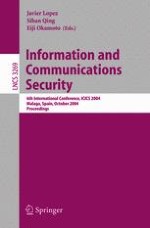2004 | Buch
Information and Communications Security
6th International Conference, ICICS 2004, Malaga, Spain, October 27-29, 2004. Proceedings
herausgegeben von: Javier Lopez, Sihan Qing, Eiji Okamoto
Verlag: Springer Berlin Heidelberg
Buchreihe : Lecture Notes in Computer Science
Enthalten in: Professional Book Archive
